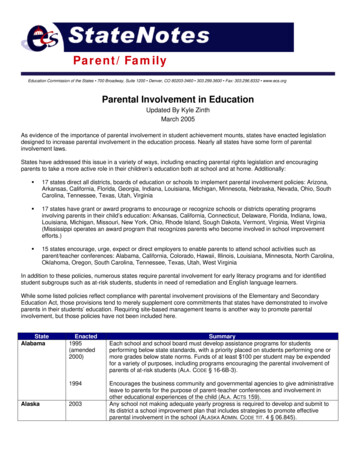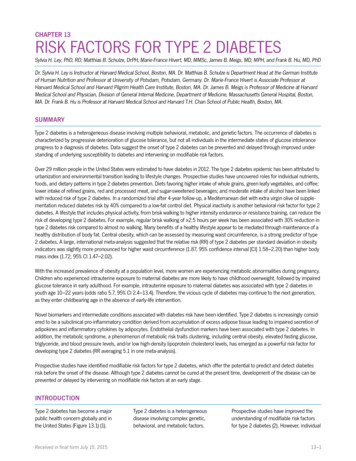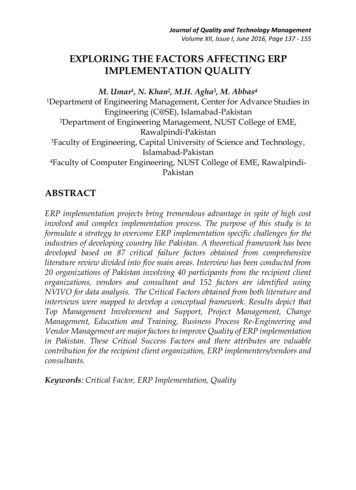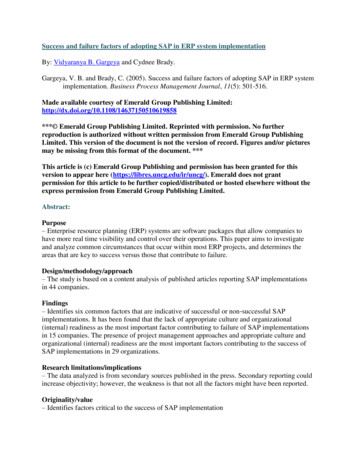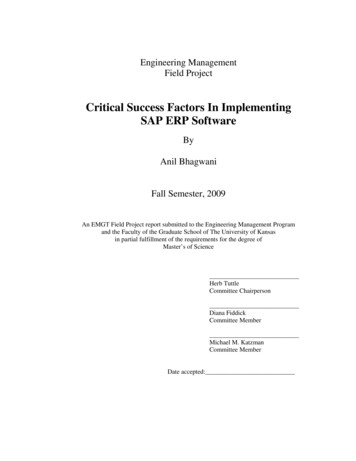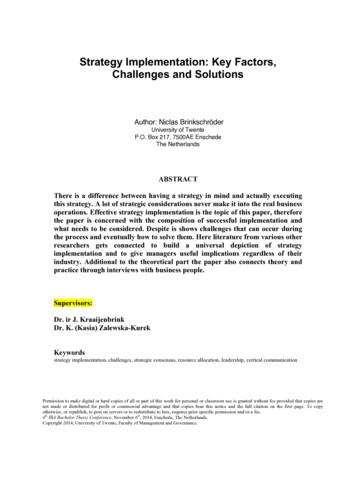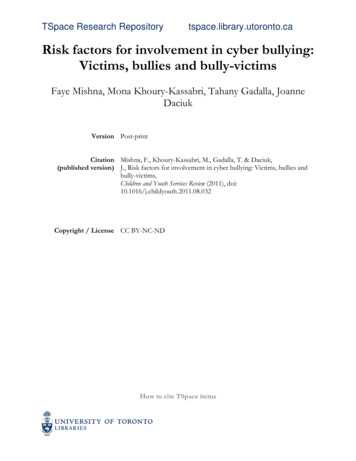
Transcription
TSpace Research Repositorytspace.library.utoronto.caRisk factors for involvement in cyber bullying:Victims, bullies and bully-victimsFaye Mishna, Mona Khoury-Kassabri, Tahany Gadalla, JoanneDaciukVersion Post-printCitation Mishna, F., Khoury-Kassabri, M., Gadalla, T. & Daciuk,(published version) J., Risk factors for involvement in cyber bullying: Victims, bullies andbully-victims,Children and Youth Services Review (2011), doi:10.1016/j.childyouth.2011.08.032Copyright / License CC BY-NC-NDHow to cite TSpace items
TSpace Research Repositorytspace.library.utoronto.caAlways cite the published version, so the author(s) will receive recognition through services that trackcitation counts, e.g. Scopus. If you need to cite the page number of the TSpace version (original manuscript oraccepted manuscript) because you cannot access the published version, then cite the TSpace version inaddition to the published version using the permanent URI (handle) found on the record page.
Risk factors for involvement in cyber bullying: Victims, bullies and bullyvictimsFaye Mishna, Mona Khoury-Kassabri, Tahany Gadalla, Joanne DaciukPII:DOI:Reference:S0190-7409(11)00334-3doi: 10.1016/j.childyouth.2011.08.032CYSR 1716To appear in:Children and Youth Services ReviewReceived date:Revised date:Accepted date:29 June 201124 August 201129 August 2011Please cite this article as: Mishna, F., Khoury-Kassabri, M., Gadalla, T. & Daciuk,J., Risk factors for involvement in cyber bullying: Victims, bullies and bully-victims,Children and Youth Services Review (2011), doi: 10.1016/j.childyouth.2011.08.032This is a PDF file of an unedited manuscript that has been accepted for publication.As a service to our customers we are providing this early version of the manuscript.The manuscript will undergo copyediting, typesetting, and review of the resulting proofbefore it is published in its final form. Please note that during the production processerrors may be discovered which could affect the content, and all legal disclaimers thatapply to the journal pertain.
ACCEPTED MANUSCRIPTTRunning Head: Cyber Bullying BehaviorsNUSCRIPRisk Factors for Involvement in Cyber Bullying: Victims, Bullies and Bully-VictimsFaye Mishna, Ph.D.MAFactor-Inwentash Faculty of Social Work, University of TorontoEDMona Khoury-Kassabri, Ph.D.CEPTSchool of Social Work and Social Welfare, the Hebrew University of JerusalemTahany Gadalla, Ph.D.ACFactor-Inwentash Faculty of Social Work, University of TorontoJoanne Daciuk, B.A., B.Ed.Factor-Inwentash Faculty of Social Work, University of Toronto
ACCEPTED MANUSCRIPTCorrespondence should be addressed to Faye Mishna, University of TorontoFactor-Inwentash Faculty of Social Work, 246 Bloor Street West, Toronto, Ontario, Canada.CRIPTE-mail: f.mishna@utoronto.caNUSWe would like to acknowledge Bell Canada for providing support for this research.MAAbstractThe use of online technology is exploding worldwide and is fast becoming a preferredEDmethod of interacting. While most online interactions are neutral or positive the InternetPTprovides a new means through which children and youth are bullied. The aim of this groundedtheory approach was to explore technology, virtual relationships and cyber bullying from theCEperspectives of students. Seven focus groups were held with 38 students between fifth andACeighth grades. The participants considered cyber bullying to be a serious problem and somecharacterized online bullying as more serious than ‗traditional‘ bullying because of theassociated anonymity. Although the students depicted anonymity as integral to cyber bullying,the findings suggest that much of the cyber bullying occurred within the context of their socialgroups and relationships. Findings revealed five major themes: technology embraced at youngerages and becoming the dominant medium for communication; definitions and views of cyberbullying; factors unique to cyber bullying; types of cyber bullying; and telling adults. Thefindings highlight the complexity of the perceived anonymity provided by the Internet and how2
ACCEPTED MANUSCRIPTthis may impact cyber bullying. The study offers greater awareness of the meanings of onlineCRcyber bullying; focus groups; bullying; online bullying; online relationships;CEPTEDMANUSchildren and youthACKeywords:IPTrelationships for children and youth.3
ACCEPTED MANUSCRIPTOngoing and Online: Children and Youth‘s Perceptions of Cyber BullyingIntroductionTThe exponential growth of electronic and computer based communication and informationIPsharing during the last decade has drastically altered individuals‘ social interactions, learningCRstrategies and choice of entertainment. In particular, there is a rapid rise of social networking onNUSthe Internet created by the growing access and use of electronic communication tools such as email, websites, instant messaging, webcams, chat rooms, social networking sites, blogs, and textmessages (Hinduja & Patchin, 2009; Palfrey & Gasser, 2008; Schrock & Boyd, 2008). Indeed itMAhas been suggested that the majority of youth view these electronic communication tools as―critical tools for their social life‖ (Kowalski, Limber, & Agatston, 2008, p. 2). The InternetEDprovides innumerable possibilities for growth among children and youth, including benefits suchPTas social support, identity exploration, and development of interpersonal and critical thinkingskills, as well as educational benefits generated from expansive access to knowledge, academicCEsupport, and worldwide cross-cultural interactions (Gross, 2004; Jackson, von Eye, Biocca,ACBarbatsis, Zhao, & Fitzgerald, 2006; Valkenburg & Peter, 2007). Although most of theinteractions are considered positive or neutral, more recent attention has focused onunderstanding cyber risks and the potential for abuse as youth spend more time online than everbefore (Mitchell, Finkelhor, & Wolak, 2003; Shariff, 2009).Although traditional bullying has long been considered a school-based problem (Craig &Pepler, 2008), electronic communication tools are moving the discussion of bullying into therealm of the electronic information highway. Similar to traditional bullying, cyber bullying, alsoknown as electronic bullying or online social cruelty (Kowalski et al., 2008), includes ―willfuland repeated harm inflicted‖ (Hinduja & Patchin, 2009, p. 5) towards another. What makes4
ACCEPTED MANUSCRIPTcyber bullying distinct is the use of electronic communication technology as the means throughwhich to threaten, harass embarrass, or socially exclude (Hinduja & Patchin, 2009; Patchin &THinduja, 2006; Williams & Guerra, 2007). Cyber bullying can encompass the use of anIPelectronic medium to sexually harass (Hinduja & Patchin, 2008; Shariff & Johnny, 2007),CRincluding distributing unsolicited text or photos of a sexual nature or requesting sexual acts eitherNUSonline or offline (Schrock & Boyd, 2008). There has been a recent spike in the academicliterature devoted to this new form of bullying (Berson, Berson, & Ferron, 2002; Hinduja &Patchin, 2009; Lenharrt, 2007; Mitchell et al., 2003; Wolak, Mitchell, & Finkelhor, 2006; YbarraMA& Mitchell, 2004a,b) including large surveys to determine normative data on the prevalence andcharacter of cyber bullying.EDIn this paper we add to the growing body of literature by exploring the perspectives ofPTstudents in grades 5 through 8 (10-13 years) in a large urban centre to provide indepth views ofcyber bullying. Qualitative inquiry provides a research design capable of discovering importantCEdiscourses and nuances of cyber bullying that might be less visible in large scale studies. This isACespecially important given that previous research has suggested that children may be unlikely tospeak about sensitive issues such as harassment and bullying (Dehue, Bolman & Vollink, 2008;Slonje & Smith, 2008). Livingstone and Haddon (2008) further argue that ―less research isqualitative or multi-method in nature, so we have less knowledge of children‘s own experiencesor perceptions, or of the ways in which online activities are contextualized within their everydaylives‖ (p. 317).Cyber BullyingThe prevalence rates of cyber bullying typically range across studies from approximately 10to 35 percent (Agatston, Kowalski & Limber, 2007; Hinduja & Patchin, 2008; Kowalski &5
ACCEPTED MANUSCRIPTLimber, 2007, 2008; Li, 2007; Patchin & Hinduja, 2006; Williams & Guerra, 2007), whereasothers have found significantly higher rates (Juvonen & Gross, 2008; Raskauskas &TStoltz, 2007). Research provides a picture of the significant psychosocial and academic effectsIPof cyber bullying. Students who were cyber bullied reported feelings of sadness, anxiety, andCRfear, and an inability to concentrate which affected their grades (Beran & Li, 2005). Youth whoNUSwere bullied online were more likely to have skipped school, to have had detentions orsuspensions, or to have carried a weapon to school (Ybarra, Diener-West, & Leaf, 2007).Depression, substance use and delinquency are significantly higher among youth who reportMAexperiencing cyber bullying (Mitchell, Ybarra, & Finklhor, 2007). Evidence reveals that youthwho perpetrate cyber bullying are more likely to concurrently engage in rule-breaking and toEDhave problems with aggression (Ybarra & Mitchell, 2007). Kowalski and Limber (2008)PTsurveyed over 900 students in grades 6 to 12 and found that students who both bullied and werethan other students.CEvictimized in the previous two months were more anxious, depressed and had lower-self-esteemACA large proportion of children and youth do not disclose their experiences of cyber bullyingto their parents (O‘Connell, Price, & Barrow, 2004). This troubling finding corresponds with thestable results that a significant percentage of children who are bullied through traditionalmethods do not tell adults (Hanish & Guerra, 2000; Mishna & Alaggia, 2005). The purpose ofthis study was to gain understanding of children and youths‘ views of cyber bullying and offactors that either helped or hindered telling parents and other adults.MethodologyGrounded theory was selected as it provided a framework to inductively explore childrenand youth‘s perceptions and opinions regarding cyber bullying (Glaser, 1978; Strauss & Corbin,6
ACCEPTED MANUSCRIPT1998). Given the dramatic growth of children and adolescents‘ use of online technologies forsocial connections and the relative lack of knowledge about cyber bullying, a grounded theoryTapproach was deemed most appropriate to allow participants‘ perspectives to emerge and toIPexplore the complexity of this phenomenon. Focus groups are an innovative approach toCRunderstanding children and adolescents‘ experiences, and have been defined as a ―carefullyNUSplanned discussion designed to obtain perceptions on a defined area of interest in a permissive,nonthreatening environment‖ (Kruger 1994, p. 6). Unlike interviews, focus groups with childrenremove the emphasis of the adult-child relationship in data collection methods (Heary &MAHennessy, 2002) by providing children of similar ages the opportunity to share their experiencesand perceptions among their peers. Horner (2000) suggests that children ―are more relaxed andEDwilling to share perceptions when discussions are held with a group of peers‖ (p. 510). ThePTpresent study received ethics approval from the University of Toronto Research Ethics Boardand from one school board‘s External Research Review Committee. The second school boardACParticipantsCEaccepted the approval of the university and the first school board.Students who were in grades 5 through 8 and who self-identified as regular Internet userswere recruited to participate, from five schools within two urban school boards. Approval wasobtained from the Boards of Education to conduct focus groups during school hours. Schoolswere purposively selected from each of the four geographical regions/quadrants of the city inwhich the larger school board is divided; northeast, northwest, southeast and southwest. Oncepotential schools were identified, principals were contacted by letter inviting them to participatefollowed by a telephone call. In schools for which principals gave consent to participate, theresearch team made presentations to teachers and students in the identified grades, during7
ACCEPTED MANUSCRIPTassemblies and staff meetings. Each student was then given an package with information andconsent forms to take home. The parents of each student that participated in the study providedTwritten informed consent, after which assent was obtained from the participating student.IPData Collection and AnalysisCRThe research team was involved with relevant stakeholders for several months in preparationNUSfor and during the time the focus groups were conducted. An advisory committee wasestablished comprising representatives from the school boards, which included guidancecounsellors, safe school team members, social workers, psychologists, and informationMAtechnology personnel. This committee helped to develop the questions and to identify schools tobe included in the research.EDThe facilitators included a Ph.D. student who was a school social worker with several yearsPTof experience, a Ph.D. student with several years of experience, and a Master of Social Workstudent who received training to co-lead focus groups. The children were asked to maintainCEconfidentiality within the focus group. Each focus group lasted approximately one hour. SomeACquestions were asked to determine participants‘ opinions about the frequency with whichchildren and youth use the Internet, cell phones and other forms of communication technology.The students were asked about their views of cyber bullying, for example how often it occurs,what forms it takes, who does the bullying, who is bullied, who knows, and whether and whothey tell. Participants were not asked about their own experiences of cyber bullying, in order toprotect their confidentiality in the groups. The students were not asked potentially sensitivequestions about Internet behaviours in reference to their peers in order to promote openness inthe group setting and to lessen the tendency for socially desirable responses (Morgan, 1998). Asemi-structured template was developed. Following the constant comparative method (Creswell,8
ACCEPTED MANUSCRIPT1998), the interview guide was updated upon completion of each focus group and before thesubsequent group. This entailed the principal investigator listening to the audio files after eachTsession, making notes based on the children‘s responses, and revising the template to ensure thatIPthe next focus group included questions based on participants‘ responses.CRThe focus groups were digitally recorded and transcribed verbatim. Transcripts wereNUSanonymized to ensure participant and school confidentiality. Inductive data analysis wasconducted using a constant comparative method (Glaser & Strauss, 1967). Line-by-line reviewof the transcripts was conducted and first-level codes (descriptors of key components of theMAfocus groups), including in vivo codes (participants‘ language), were noted in the margins(Charmaz, 2006; Glaser, 1978). Transcripts were inputted into NVivo (Richards, 1999) andEDcoded into interconnecting themes. Codes were tagged to associated segments of text. Then, thePTinvestigators reviewed text corresponding to each of the first-level codes. Using focused codingand a constant comparative method (Charmaz, 2006; Glaser & Strauss, 1967), first-level codesCEwere further refined and organized into categories. Finally, theoretical coding was undertaken toACidentify higher level codes and relationships among categories, and to ensure category saturation(Charmaz, 2006; Glazer, 1978). Coding discrepancies were resolved by consensus among thethree investigators.Seven focus groups were conducted with 38 students in grades 5-8, comprising 17 boys and21 girls. The groups were: group 1: N 7, 3 boys and 4 girls; group 2: N 6, 6 boys; group 3:N 4, 1 boy and 3 girls; group 4: N 6, 6 girls; group 5: N 3, 3 boys; group 6: N 5, 2 boys and 3girls; group 7: N 7, 2 boys and 5 girls. Although it has been suggested that focus groups withchildren should include homogeneous single-sex groups (Hoppe et al., 1995) using mixed gendergroups has resulted in some of the richest findings due to the differences in opinions and9
ACCEPTED MANUSCRIPTexperiences of boys and girls (Davis, & Jones 1996; Heary & Hennessy 2002). Since the focuswas not the children‘s personal experiences it was believed the groups could be either mixed orTsame gender.IPResultsCRUsing qualitative methodology, this study explored students‘ views of cyber bullying. TheNUSresults provide rich understanding of cyber bullying from the students‘ perspectives andcorrespond with research findings in the literature. Themes that emerged in this study includetechnology embraced at younger ages and becoming the dominant medium; participants‘MAdefinitions and views of cyber bullying; factors unique to cyber bullying; types of cyberbullying; and telling adults.EDTechnology Embraced at Younger Ages and Becoming the Dominant MediumPTThe participants were adamant that the age at which children use the Internet and othercommunication technology is becoming ―younger and younger.‖ They offered as evidence theirCEown experiences and observations of their younger siblings. For example, one boy expressedACconcern that his four year old brother ―already plays games on the Internet.‖ Even the grade fivestudents, representing the youngest age group in our sample were adept with communicationtechnologies and articulated the benefits and dangers. All the students reported that they andtheir peers spend a minimum of three hours on their computers daily, after school and maintainedthat children spend more time on the computer than they do watching television. Somecommented that they know ―lots‖ of children (themselves included) with both a computer andtelevision in their bedroom and that they often talk to friends on MSN while watching television.10
ACCEPTED MANUSCRIPTDefinitions and Views of Cyber BullyingThe participants all defined cyber bullying as a form of bullying which they compared toT‗traditional‘ bullying. Some forms of cyber and traditional bullying which they consideredIPsimilar included spreading rumors, and making threats and derogatory comments. One 10 yearCRold girl for instance, exclaimed, ―cyber bullying oh my god! It‘s another way to bully just overNUSthe computer. Some people do cyber bullying as a joke and don‘t know what it feels to bebig bullies‖ who engage inbullied.‖ Many participants emphasized that it is not just the ―bullying others online and that individuals who might be too timid to bully others in ―real life‖MAmight do so in the virtual world. These students talked about the Internet providing anonymity,which they believed fostered bullying by some children who would not otherwise bully.EDSeveral participants emphasized that in cyber bullying situations, children were often atPThome in their room with the expectation of safety, which was especially distressing. Forinstance, a 10 year old boy said, ―You can‘t physically hurt somebody through cyber bullying,CEbut you can definitely hurt your feelings. You can say many hurtful things and make you feelACreally sad, because you‘re in your own safe place. You‘re in your home.‖Most students stated that bullying now can happen all day since technology has extended‗schoolyard bullying‘ to home computers and cell phones, making it possible for ―non-stopbullying.‖ When discussing the frequency of cyber bullying participants used terms such as―spreading,‖ ―everywhere technology is,‖ and ―as widespread as computers.‖ Most expressedconcern about the frequency and considered cyber bullying a serious problem that could causedamage. As one 10 year old boy explained, ―I think cyber bullying is much worse than
cyber bullying distinct is the use of electronic communication technology as the means through which to threaten, harass embarrass, or socially exclude (Hinduja & Patchin, 2009; Patchin & . assemblies and staff meetings. Ea
